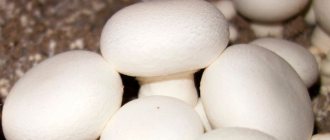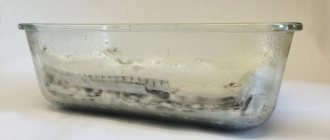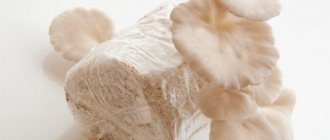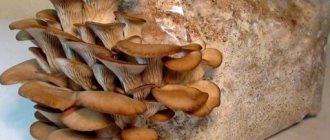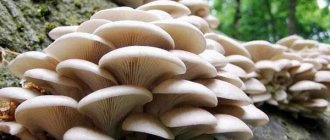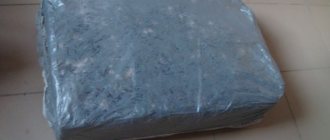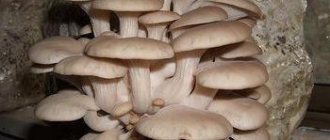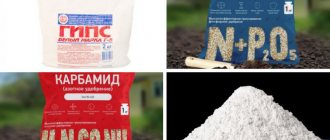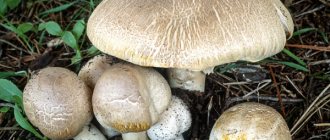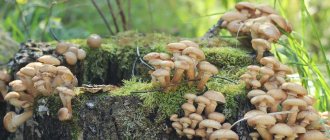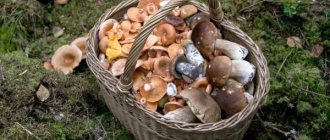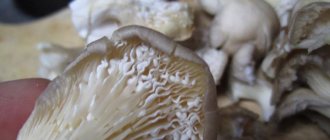Properties and purpose of mycelium
Mycelium is the vegetative body of a fungus, capable of changing its shape, adapting to specific growing conditions. The mycelium forms special organs that allow it to reliably gain a foothold in the nutrient medium - soil, root, wood, substrate.
To grow boletus, saffron milk mushrooms or porcini mushrooms, you need a mycelium, a substrate and conditions suitable for the growing season.
Functions of mycelium:
- Attachment to the nutrient medium.
- Processing cellulose with the help of enzymes - to obtain substances necessary for the growth and development of fruiting bodies.
- Adaptation to environmental conditions.
- Participation in the formation and preservation of spores.
The mycelium is the most important organ responsible for transporting nutrients and vegetative propagation.
Structure and life cycle of mycelium
The mycelium has the appearance of cotton wool, a fluffy coating, a light film or a mesh woven from tiny threads. The mycelium consists of thin branched threads - hyphae. Their thickness is 1.5-10 microns. Thread color – white, light shades.
A network of small lateral branches, called haustoria, is formed on the hyphae, which allows the fungi to penetrate the internal tissues of plants, receiving water and nutrition.
If we sum up the length of all the hyphae in the mycelium, it is 30-35 kilometers in some fungi.
The hyphae, collected in bundles, look like plant roots. Tenacious hyphae help fungi to gain a foothold not only on soft substrates, but also on hard substrates. Threads rich in nutrients form sclerotia - they look like black capsules and perform protective functions. Thanks to sclerotia, the mycelium does not die even in severe cold.
Fungal development cycle:
- The life cycle of mushrooms begins with a spore - it gives rise to primary mycelium.
- After crossing cells from two different spores, secondary mycelium appears.
- The vegetative development of the secondary mycelium begins.
- After the vegetative mycelium matures, its cells have an unprecedentedly high division rate - when it reaches its peak, the construction of fruiting bodies begins.
The mycelium undergoes a final functional change, transforming into tertiary mycelium.
Mycelium forms
Myceliums are divided into two classes:
- Submerged - if they are entirely hidden in the nutrient substrate.
- Airborne - if they only touch the nutrient medium.
Mushroom mycelium is also divided into:
- Coenotic – “non-cellular”. There are no transverse partitions between cells. Such mycelium is one large cell with many nuclei.
- Septated – “cellular”. Mycelium cells are separated by intercellular partitions. Each cell has a certain number of nuclei.
Traditional methods
If the disease has only touched the mycelium with pathogenic tentacles, then the methods that have helped our ancestors for centuries can work effectively. What helps with this successfully:
- celandine,
- iodine,
- garlic,
- hydrogen peroxide,
- tea tree oil.
All procedures are carried out on the outer skin, without taking plant components internally.
Where is mycelium formed?
Mycelium is bought in specialized stores or brought from the forest. Where is mycelium formed? A network of the finest weaves - hyphae - can be found:
- on stumps, old roots, wood - depends on the type of mushroom;
- in place of the fruiting mycelium.
Take a piece of mycelium with hyphae, create favorable conditions for it, and soon - when the cells are activated, mushrooms will sprout from the threads. This is how amateur mushroom growers obtain “seedlings” for home mushroom plantings.
Methods for growing mushrooms from mycelium
To grow mushrooms, it would be a good idea to learn how to obtain mushroom mycelium yourself - it is not always possible to find the required number of myceliums in the forest, and the purchase requires serious funds. According to the method of cultivation, mycelium is distinguished:
- Uterine. It is usually bred in laboratories. Fungal strains are grown in test tubes and become seed material.
- From the body of a mushroom . For sowing, slices of overripe caps are used. Harvesting mycelium from hats follows special rules.
- Sowing. Material almost ready for sowing. It is collected from myceliums that have finished bearing fruit.
- From a stick . It can be bought in special. store.
How to grow royal mycelium?
The simplest thing is when there is a ready-made seed mycelium - it is only placed in the substrate, but the mother mycelium and from the body of the fungus still have to be prepared. To grow uterine mycelium, you will need to purchase the necessary equipment. Sowing of the material is carried out under sterile conditions. Access to heat and water resources is required. Growing technology:
- Buy:
- test tubes with stoppers;
- tweezers;
- wort;
- burner and alcohol;
- agar-agar;
- hydrogen peroxide;
- gloves are sterile.
- Everything that will participate in the process of preparing royal mycelium must be sterilized. The work area must also be sterile.
- Prepare the nutrient medium. Mix agar-agar and wort and boil until it thickens.
- Prepare slices of mushroom caps in advance. They must be washed in hydrogen peroxide and then transferred to a sterilized container.
- Pour the wort mixed with agar into test tubes - they should be placed with a slight slope. Let them cool down. Keep clean.
- Place a piece of mushroom into a warm thick substance (using tweezers or tweezers).
- Sterilize each test tube with a mushroom over a burner. Immediately after sterilization, the tube must be sealed with a stopper.
- Place the test tubes in a warm and dark place. The holding time is two weeks. As soon as this period has expired, the seed can be sown in the substrate.
Most often, it is not possible to grow the uterine mycelium yourself due to a violation of sterility. There are microorganisms in the test tubes, and as a result, instead of mycelium, there is a dominance of mold and other bacterial parasites.
Growing royal mycelium on your own is extremely difficult. It is recommended not to take risks or waste time, but to purchase a finished product from professionals. When buying mycelium, make sure:
- that it has expired;
- that storage conditions have been met.
As a rule, the shelf life of mycelium grown in vitro is limited to 3-4 months.
Growing seed mycelium from mushroom caps
This method of obtaining mycelium is simpler than the previous one. This propagation option is especially good for honey mushrooms and oyster mushrooms. How to prepare seed:
- Collect ripe caps. Choose the largest ones without damage.
- Fill the caps with boiled water. Let the dough stand for 24 hours.
- After draining the water, knead the soaked caps to make a paste.
- The mixture is not stored - it must be used immediately. Therefore, the substrate for sowing must already be ready.
If mushrooms are to be grown on stumps and cuttings, then cuts are made in the latter in advance, into which the mushroom pulp is placed. If a substrate is used, the mycelium from the hats is placed between its layers.
In order for the mushrooms to germinate successfully, the temperature must be maintained at +23-+25 degrees during the incubation period. It is also necessary to ensure high humidity in the room.
Obtaining mycelium from hats is the easiest option for home use. Other methods of growing mycelium cannot be used at home. Unless you organize a mini-laboratory equipped with autoclaves and other special equipment.
Sticks with mycelium
These are simple sticks made of hardwood. They are infected with mycelium. Shelf life is six months. Storage conditions: room temperature, humidity above 50%. In order for mushroom growth to begin, the sticks are placed in a nutrient substrate. Such mycelium can be purchased from enterprises engaged in mass production of mushrooms, or from specialized retail outlets.
Most hobbyists have gotten burned trying to grow mycelium on their own and prefer to buy a finished product. If growing mushrooms is an exciting hobby, why not try to grow mycelium yourself.
Treatment of fungal diseases
In most cases, there is a practice of using complex therapy, which includes combined treatment of the fungus. This effect ranges from the use of special drugs to surgical removal of the affected area of the plate. The use of special-purpose patches, such as salicylic and trichloroacetic patches, is also encouraged.
If it is not possible to neutralize the pathology with medication, then after surgical removal of the nail, postoperative care is prescribed, which consists of using products that quickly help the wound heal and create a clean place for the appearance of a healthy nail.
Read also: Why is mycosis of the esophagus dangerous?
How to choose a substrate?
Choosing a substrate - the material in which mushrooms will grow - is not an easy task. Firstly, it must be ideal for growing a specific type of mushroom - oyster mushrooms, champignons, porcini mushrooms, etc. Some species require a soft substrate, others prefer to grow on hard wood.
There are several substrate options; the mushroom grower’s task is to choose the best option for specific mushrooms and goals.
From straw
Use rye, wheat or oat straw. This is a cheap and accessible material. And most importantly, it is universal - almost any mushroom can be grown on straw. Mushrooms easily destroy and absorb the nutritional fibers of straw. The disadvantage of straw substrate is the need for sterilization (pasteurization). Any straw contains mold spores and other parasitic fungi that will compete with the cultivated fungus for food supply.
Log substrate
Mushrooms taste better on logs than on straw substrates. The mushroom takes a long time to grow into wood, but good harvests are obtained. Mushrooms are grown on deciduous wood - maple, poplar, willow, birch, chestnut, ash, and also on fruit trees. Not suitable - black walnut and white acacia. The nuances of growing on logs:
- Only healthy wood is used - without traces of other fungi.
- The presence of moss and lichen is allowed, but they are cleaned before sowing.
- It is best to cut down in late February to mid-March. At this time, sap flows through the tree. The mushrooms will receive an extremely nutritious environment.
- Log length – 50-150 cm. Diameter – 10-15 cm or more. Thin logs may break.
- A freshly cut log should sit for about six months before moving in. Logs should be stored in clean and ventilated areas. The tree should not come into contact with the ground.
- The ideal time to move in is spring, after frost. It is better not to sow in hot weather.
To grow on logs you will need:
- logs;
- 5/16 drill bit and drill;
- rubber hammer;
- work surface - for example, a workbench;
- natural wax;
- brush - apply wax;
- mushroom sticks.
Sawdust
The best sawdust for growing mushrooms is from deciduous trees. The choice is made like logs. You cannot use sawdust that is too small - it can become compressed and the mycelium will suffocate.
Pure sawdust has few nutrients. To increase nutritional value, bran is added to sawdust - they receive nitrogen. On empty sawdust, fungi grow thin, flimsy, with poorly developed caps. The sawdust is pasteurized before use.
Alternative substrates
In addition to logs, straw and sawdust substrates, you can use:
- sleepy coffee grounds;
- sleeping tea leaf;
- cardboard (without dyes);
- compost, garden waste;
- paper (if newspapers are used, you need to make sure the ink is non-toxic);
- sunflower husks, corn cobs, other organics.
The substrate is selected taking into account the type of fungus and the type of mycelium. If you bought mushroom sticks, then wood will serve as the substrate. You can also use straw, but in wood the mycelium, which is already familiar with the wood fibers, will germinate faster.
How to grow mushrooms?
First you need to decide what kind of mushrooms you will grow. Based on this, you will select the optimal substrate. The first thing you need to do is find out where it’s best to get mycelium. You can grow it yourself. Growing mushrooms allows you not only to provide your family with a tasty, nutritious product, but also to create your own business. To start your own business you will need:
- A room with special conditions - humid, warm, illuminated, ventilated.
- Investments in the room will depend on the type of mushroom. For example, oyster mushrooms are not particularly picky about environmental conditions, but champignons, on the contrary, require attention and careful care.
- Decide on a growing method. There is an intensive method - mushrooms are grown all year round on different substrates, and an extensive method - which involves limited yield.
- Substrate is the basis for growing. You can prepare it yourself, for example, from straw or sawdust, or you can purchase it from companies specializing in the sale of equipment for mushroom growing. If you organize things correctly, then from 10 kg of substrate you can get more than 2 kg of mushrooms. It is important that the substrate is environmentally friendly - without synthetic fertilizers and chemical additives. The presence of “chemicals” worsens the taste and yield of mushrooms. It happens that mushrooms do not grow at all on substrates oversaturated with chemical additives.
- Mycelium. Mycelium is sown into the prepared substrate. For 100 kg of substrate you need 3-5 kg. The mycelium is purchased or prepared independently - by growing it from the body of a mushroom. Obtaining mushroom mycelium at home is a difficult, but quite feasible task.
Today it is difficult to find a company that would guarantee 100% quality of the mycelium sold. To successfully grow mycelium, you will need a room with a constant temperature (+20-+30°C) and humidity, lighted and ventilated.
If you follow the technology and provide favorable growing conditions, then after a couple of weeks the embryos of fruiting bodies will appear, from which clusters of mushrooms will grow. Fruiting is wavy in nature. As a rule, when grown on a substrate in bags, three crops are harvested, after which the bags are changed.
Mechanism of transmission of nail fungus
Infection with pathogenic fungal spores can occur through any contact with an infected object. The mycelia of the fungus, getting on the nails, begin to conduct active occupying activities, trying to settle in a new place as soon as possible.
Infection can occur even with a normal handshake if basic hygiene is not observed. Although the danger of disease also arises when a person works for a long period in a humid environment. To minimize the risk of acquiring long and difficult treatment, it is necessary to follow sanitary recommendations.
What mushrooms are grown from mycelium?
If you have a summer house or a personal plot, then, in addition to vegetables and fruits, you can also grow mushrooms on it - a delicious product that will diversify your diet. And if you get the hang of it, you can go big and grow mushrooms for sale. And not only traditional oyster mushrooms and champignons, but also honey mushrooms, boletus mushrooms, and other mushrooms with good taste and yield. Let's find out which mushrooms are best grown from mycelium.
Champignon
Champignon is a mushroom, the most popular in mass production. There are three types of champignons - white, cream and brown. The easiest way to grow white champignons from mycelium is that they are less capricious and produce seven harvests per year. For successful cultivation you need:
1. Create favorable temperature and humidity in the greenhouse.
2. Prepare a special substrate. To prepare it you will need:
- chopped straw of winter grains;
- horse, cow, rabbit or pig manure;
- urea;
- lime, chalk or gypsum.
The substrate is prepared following the following proportions:
- straw – 100 kg;
- manure – 50 kg;
- urea – 300 g;
- water – 300 l.
It is advisable to add superphosphate - 300 g. The compost is laid out on the film, stirring and moistening for 10 days. It is necessary to ensure that there is no excess of ammonia and carbon dioxide in the substrate.
3. The finished substrate is laid out in boxes - a layer of 20 cm.
4. Prepare mycelium:
- Grain. Place the grain mixture in a metal bowl and pour in water - it should cover by 2-3 cm. Cook for 1 hour. After straining the grain, it is dried. Pour into jars, filling them 50%. Sterilized. Place some mycelium in the cooled jars. When white fluff appears, it will become clear that the mycelium is developing successfully. After a week, the finished mycelium can be planted.
- From mushroom legs . Soak the corrugated cardboard for 1 hour. Cuts are made on the stem of the mushroom and divided into fibers. Drainage holes are made in the container for the “farm”. Mushroom fiber is placed on the soaked cardboard, covered with wet cardboard - it is removed from above, and a press is placed. When the leaf turns white, the mycelium is ready and can be placed in the nutrient mixture.
5. Place the mycelium in the substrate. Cover the boxes with paper. The mycelium will begin to germinate in 2-3 weeks.
Oyster mushrooms
This productive and unpretentious mushroom is grown on:
- hardwood;
- in bags with substrate - it is prepared from sunflower husks, sawdust and straw.
For planting you need high-quality mycelium. Healthy oyster mushroom mycelium is white or cream in color. To the touch - dry. It is purchased in late autumn or early spring - before the temperature rises above +3°C. Procedure for growing oyster mushrooms:
- Preparing the premises - for example, a greenhouse.
- Planting can begin in November, then the first mushrooms will be obtained by the end of winter.
- Preparation of logs. Take cuttings - up to 0.5 m long, 40 cm in diameter. Dry wood is soaked for 2 days. Fresh wood is not soaked.
- The finished trimmings are infected with mycelium. For this purpose, each cut is generously sprinkled with mycelium - a layer of about 1 cm. Four logs are stacked on top of each other. Cover with burlap or sprinkle with sawdust. The distance between the bars is at least 40 cm.
- The room temperature is maintained at +13-+15°C. Humidity – 90%. Oyster mushrooms do not like light - if there is too much of it, the mycelium may die. After the start of fruiting, you need to increase the temperature to +25°C. From one stump you get 0.5-2.5 kg of mushrooms.
In addition to logs, you can use bags for growing oyster mushrooms:
- The material is used of one type or in the form of a mixture.
- The crushed raw materials are placed in an enamel container and poured with boiling water for 12 hours.
- Drain the water and squeeze out the raw material.
- After mixing the substrate with mycelium, fill bags with the mixture.
- Make holes in the bags so mushrooms will grow through them.
A specialist mushroom grower talks about all the stages of growing oyster mushroom mycelium at home:
Porcini
Porcini mushrooms are not grown indoors. They need a site where birch, pine or oak trees grow. Procedure for growing boletus mushrooms:
- Planting can be done between late spring and early autumn. It should be warm outside.
- To prepare the mycelium, take the hats of healthy, ripe boletus mushrooms. The hats are soaked for 2 hours - fill them with clean cold water. Then add sugar - 200 g and break into pieces. After this, the hats lie in sweetened water for another 2 hours.
- Remove 20 cm of the top layer under the trees (under which the mushrooms will grow), pour out the finished mycelium. The first mushrooms will appear in a year. It is important to maintain optimal humidity. If the soil is waterlogged, the mycelium will begin to rot.
Honey mushrooms
It is not possible for everyone to grow honey mushrooms on a plot right away. The procedure for growing honey mushrooms from mycelium:
- Wood harvesting - it is transferred to the planting site. The site is selected so that there is no wind and sun.
- Mycelium is prepared from the fruiting bodies of mushrooms in the usual way, or you can buy it ready-made. You can put mycelium sticks into wood.
- In order for the mycelium to penetrate the soil, chocks are dug to 2/3 of the height. The interval between the chocks is 10-15 cm.
- From the moment the substrate is infected with mycelium until fruiting, 45 days pass.
It is recommended to plant honey mushrooms in open ground in the spring - in trunks saturated with moisture and nutrients.
Growing mycelium at home complicates the already difficult process of growing mushrooms. Buy a mycelium or grow it yourself - each mushroom grower decides for himself.
0
0
Copy link
Cultivation of champignons
Mycelium seeds for champignons should have a loose structure, a characteristic odor and a white color. Production will require a separate disinfected room without sunlight. The champignon successfully bears fruit in the dark, and weak artificial light is enough to carry out the work.
The seeds of this mycelium require a high-quality substrate, which you can buy (if large volumes of crops are grown) or make yourself. Approximately 100 g of compost is lined per square meter of container.
Champignon mycelium seeds are planted in the soil when it is warmed up to 18-25°C, but no more. They are covered with substrate on top, covered with a layer of newspapers and moistened by spraying water. Fruiting lasts up to two months, during which time up to 6 harvests can be harvested.
The photo shows champignon mushroom seeds
There is no substitute for a walk through the forest in search of edible mushrooms for lunch or for pickling. However, in the absence of forests, their independent seasonal cultivation, for example in the country, is not only a way to diversify your diet, but also an excellent opportunity to replenish the family budget.
